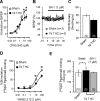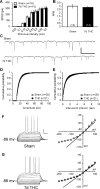Presynaptic homeostatic plasticity rescues long-term depression after chronic Delta 9-tetrahydrocannabinol exposure
- PMID: 16354920
- PMCID: PMC6726043
- DOI: 10.1523/JNEUROSCI.2294-05.2005
Presynaptic homeostatic plasticity rescues long-term depression after chronic Delta 9-tetrahydrocannabinol exposure
Abstract
Alterations of long-term synaptic plasticity have been proposed to participate in the development of addiction. To preserve synaptic functions, homeostatic processes must be engaged after exposure to abused drugs. At the mouse cortico-accumbens synapses, a single in vivo injection of Delta9-tetrahydrocannabinol (THC) suppresses endocannabinoid-mediated long-term depression. Using biochemical and electrophysiological approaches, we now report that 1 week of repeated in vivo THC treatment reduces the coupling efficiency of cannabinoid CB1 receptors (CB1Rs) to G(i/o) transduction proteins, as well as CB1R-mediated inhibition of excitatory synaptic transmission at the excitatory synapses between the prefrontal cortex and the nucleus accumbens (NAc). Nonetheless, we found that cortico-accumbens synapses unexpectedly express normal long-term depression because of a reversible switch in its underlying mechanisms. The present data show that, in THC-treated mice, long-term depression is expressed because a presynaptic mGluR2/3 (metabotropic glutamate receptor 2/3)-dependent mechanism replaces the impaired endocannabinoid system. Thus, in the NAc, a novel form of presynaptic homeostasis rescues synaptic plasticity from THC-induced deficits.
Figures







Similar articles
-
Properties of 4 Hz stimulation-induced parallel fiber-Purkinje cell presynaptic long-term plasticity in mouse cerebellar cortex in vivo.Eur J Neurosci. 2014 May;39(10):1624-31. doi: 10.1111/ejn.12559. Epub 2014 Mar 26. Eur J Neurosci. 2014. PMID: 24666426
-
Presynaptic CB1 receptors regulate synaptic plasticity at cerebellar parallel fiber synapses.J Neurophysiol. 2011 Feb;105(2):958-63. doi: 10.1152/jn.00980.2010. Epub 2010 Nov 17. J Neurophysiol. 2011. PMID: 21084685 Free PMC article.
-
ERK-dependent modulation of cerebellar synaptic plasticity after chronic Delta9-tetrahydrocannabinol exposure.J Neurosci. 2006 May 24;26(21):5810-8. doi: 10.1523/JNEUROSCI.5469-05.2006. J Neurosci. 2006. PMID: 16723539 Free PMC article.
-
Endocannabinoids and synaptic function in the CNS.Neuroscientist. 2007 Apr;13(2):127-37. doi: 10.1177/1073858406296716. Neuroscientist. 2007. PMID: 17404373 Review.
-
[Acquiring new information in a neuronal network: from Hebb's concept to homeostatic plasticity].J Soc Biol. 2008;202(2):143-60. doi: 10.1051/jbio:2008018. Epub 2008 Jun 13. J Soc Biol. 2008. PMID: 18547512 Review. French.
Cited by
-
Maternal Exposure to the Cannabinoid Agonist WIN 55,12,2 during Lactation Induces Lasting Behavioral and Synaptic Alterations in the Rat Adult Offspring of Both Sexes.eNeuro. 2020 Sep 15;7(5):ENEURO.0144-20.2020. doi: 10.1523/ENEURO.0144-20.2020. Print 2020 Sep/Oct. eNeuro. 2020. PMID: 32868310 Free PMC article.
-
Protein Interactors and Trafficking Pathways That Regulate the Cannabinoid Type 1 Receptor (CB1R).Front Mol Neurosci. 2020 Jun 12;13:108. doi: 10.3389/fnmol.2020.00108. eCollection 2020. Front Mol Neurosci. 2020. PMID: 32595453 Free PMC article. Review.
-
Cannabis use, abuse, and withdrawal: Cannabinergic mechanisms, clinical, and preclinical findings.J Neurochem. 2021 Jun;157(5):1674-1696. doi: 10.1111/jnc.15369. Epub 2021 May 16. J Neurochem. 2021. PMID: 33891706 Free PMC article. Review.
-
Nicotine and behavioral sensitization.J Mol Neurosci. 2010 Jan;40(1-2):154-63. doi: 10.1007/s12031-009-9230-7. Epub 2009 Aug 11. J Mol Neurosci. 2010. PMID: 19669944 Free PMC article. Review.
-
Presynaptic long-term plasticity.Front Synaptic Neurosci. 2013 Oct 17;5:8. doi: 10.3389/fnsyn.2013.00008. Front Synaptic Neurosci. 2013. PMID: 24146648 Free PMC article. Review.
References
-
- Bacci A, Huguenard JR, Prince DA (2004) Long-lasting self-inhibition of neocortical interneurons mediated by endocannabinoids. Nature 431: 312–316. - PubMed
-
- Breivogel CS, Childers SR, Deadwyler SA, Hampson RE, Vogt LJ, Sim-Selley LJ (1999) Chronic delta9-tetrahydrocannabinol treatment produces a time-dependent loss of cannabinoid receptors and cannabinoid receptor-activated G proteins in rat brain. J Neurochem 73: 2447–2459. - PubMed
-
- Burrone J, Murthy VN (2003) Synaptic gain control and homeostasis. Curr Opin Neurobiol 13: 560–567. - PubMed
-
- Cartmell J, Schoepp DD (2000) Regulation of neurotransmitter release by metabotropic glutamate receptors. J Neurochem 75: 889–907. - PubMed
-
- Cartmell J, Monn JA, Schoepp DD (2000) The mGlu(2/3) receptor agonist LY379268 selectively blocks amphetamine ambulations and rearing. Eur J Pharmacol 400: 221–224. - PubMed
Publication types
MeSH terms
Substances
LinkOut - more resources
Full Text Sources
Other Literature Sources
